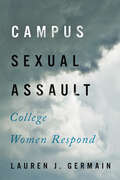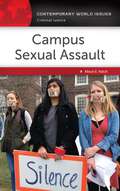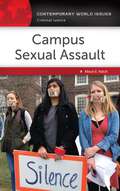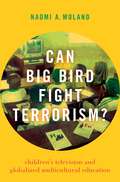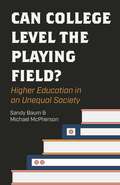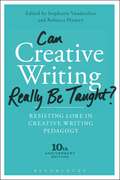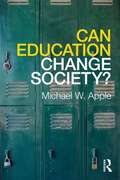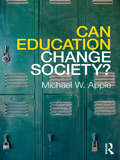- Table View
- List View
Campus Service Workers Supporting First-Generation Students: Informal Mentorship and Culturally Relevant Support as Key to Student Retention and Success (Routledge Research in Higher Education)
by Georgina Guzmán Stephanie Santos Youngblood La’Tonya Rease MilesThis unique collection of testimonials, critical essays, and first-hand accounts demonstrates the significant contribution of campus service workers in supporting the retention and success of first-generation college students. Using a Freirean framework to ground individual stories, the text identifies ways in which campus workers connect with students, provide informal mentorship, and offer culturally relevant support during students’ transition to college and beyond. Drawing on a range of interviews, case studies, and research studies, emphasis is placed on the unique challenges faced by first-generation and minority students such as cultural alienation, imposter syndrome, language barriers, and financial insecurity. Ultimately, the text dismantles notions of social hierarchies that separate workers and college students and encourages institutions to invest in these workers and their contribution to student well-being and success. This book will benefit researchers, academics, and educators with an interest in the higher education and student affair practice and higher education administration more broadly. Those specifically interested in multicultural education and the study of race and ethnicity within US higher educational contexts will also benefit from this book.
Campus Sexual Assault: College Women Respond
by Lauren J. GermainA 2014 report issued by the White House Council on Women and Girls included the alarming statistic that one in five female college students in the United States experience some form of campus sexual assault. Despite more than fifty years of anti-rape activism and over two decades of federal legislation regarding campus sexual violence, sexual assault on American college and university campuses remains prevalent, underreported, and poorly understood. A principal reason for this lack of understanding is that the voices of women who have experienced campus sexual assault have been largely absent from academic discourse about the issue.In Campus Sexual Assault, Lauren J. Germain focuses attention on the post–sexual assault experiences of twenty-six college women. She reframes conversations about sexual violence and student agency on American college campuses by drawing insight directly from the stories of how survivors responded individually to attacks, as well as how and why peers, family members, and school, medical, and civil authorities were (or were not) engaged in addressing the crimes.Germain weaves together women's narratives to show the women not as victims per se but as individuals with the power to overcome these traumatic experiences.
Campus Sexual Assault: College Women Respond
by Lauren J. GermainA 2014 report issued by the White House Council on Women and Girls included the alarming statistic that one in five female college students in the United States experience some form of campus sexual assault. Despite more than fifty years of anti-rape activism and over two decades of federal legislation regarding campus sexual violence, sexual assault on American college and university campuses remains prevalent, underreported, and poorly understood. A principal reason for this lack of understanding is that the voices of women who have experienced campus sexual assault have been largely absent from academic discourse about the issue.In Campus Sexual Assault, Lauren J. Germain focuses attention on the post–sexual assault experiences of twenty-six college women. She reframes conversations about sexual violence and student agency on American college campuses by drawing insight directly from the stories of how survivors responded individually to attacks, as well as how and why peers, family members, and school, medical, and civil authorities were (or were not) engaged in addressing the crimes.Germain weaves together women's narratives to show the women not as victims per se but as individuals with the power to overcome these traumatic experiences.
Campus Sexual Assault: A Reference Handbook (Contemporary World Issues)
by Alison E. HatchThis invaluable reference text thoroughly examines the alarming epidemic of campus sexual assault, including a discussion of laws, high-profile cases, controversies, and proposed solutions.From the assault of a high school girl by a multitude of her peers in Steubenville, Ohio, to the alleged gang rape at the University of Virginia, the ongoing and serious problem of sexual violence at U.S. educational institutions is well established. These horrific attacks continue in spite of the Title IX probe launched by the Obama administration in order to hold schools more accountable. Campus Sexual Assault: A Reference Handbook addresses the difficult questions about the widespread incidence of sexual assault among high school and college students. Written to be highly accessible to high school and undergraduate students, general readers, as well as individuals interested in the campus rape discourse, the book covers the background history of sexual assault on college campuses, discusses how laws regarding sexual assault and the cultural understanding of the crime have evolved over time, and outlines some of the highest-profile cases of sexual assault at U.S. schools. A perspectives chapter presents testimonials from those who by profession or experience have insight into the problem of sexual assault, giving voice to a Title IX investigator, a college counselor, a sexual assault nurse, and individuals who have been sexually assaulted. Readers will come away with a deeper appreciation of the gravity of the problem of campus sexual assault and grasp the causes of this societal issue to intelligently consider proposed solutions.
Campus Sexual Assault: A Reference Handbook (Contemporary World Issues)
by Alison E. HatchThis invaluable reference text thoroughly examines the alarming epidemic of campus sexual assault, including a discussion of laws, high-profile cases, controversies, and proposed solutions.From the assault of a high school girl by a multitude of her peers in Steubenville, Ohio, to the alleged gang rape at the University of Virginia, the ongoing and serious problem of sexual violence at U.S. educational institutions is well established. These horrific attacks continue in spite of the Title IX probe launched by the Obama administration in order to hold schools more accountable. Campus Sexual Assault: A Reference Handbook addresses the difficult questions about the widespread incidence of sexual assault among high school and college students. Written to be highly accessible to high school and undergraduate students, general readers, as well as individuals interested in the campus rape discourse, the book covers the background history of sexual assault on college campuses, discusses how laws regarding sexual assault and the cultural understanding of the crime have evolved over time, and outlines some of the highest-profile cases of sexual assault at U.S. schools. A perspectives chapter presents testimonials from those who by profession or experience have insight into the problem of sexual assault, giving voice to a Title IX investigator, a college counselor, a sexual assault nurse, and individuals who have been sexually assaulted. Readers will come away with a deeper appreciation of the gravity of the problem of campus sexual assault and grasp the causes of this societal issue to intelligently consider proposed solutions.
Campus Unions: Organized Faculty and Graduate Students in U.S. Higher Education, ASHE Higher Education Report (J-B ASHE Higher Education Report Series (AEHE))
by Timothy Reese CainWith roughly 25% of those teaching college classes belonging to a union, higher education is one of the most heavily organized industries in the United States. Substantial research-based literature exists as scholars have been studying the topic for a half of a century. Following an overview of its history and context, this monograph synthesizes and analyzes the existing research on faculty and graduate student unionization. It points to evolving understandings of faculty attitudes regarding collective bargaining and the findings on the relationships between unionization and compensation, satisfaction, procedural protections, organizational effectiveness, and related issues for tenure-line faculty. Additional chapters consider the more limited research on non-tenure-line faculty and graduate student instructors. As such, this monograph illuminates the accepted understandings, contested arguments, and the substantial gaps in understandings that remain. This is the third issue of the 43rd volume of the Jossey-Bass series ASHE Higher Education Report. Each monograph is the definitive analysis of a tough higher education issue, based on thorough research of pertinent literature and institutional experiences. Topics are identified by a national survey. Noted practitioners and scholars are then commissioned to write the reports, with experts providing critical reviews of each manuscript before publication.
Campus Unions: Organized Faculty and Graduate Students in U.S. Higher Education, ASHE Higher Education Report (J-B ASHE Higher Education Report Series (AEHE))
by Timothy Reese CainWith roughly 25% of those teaching college classes belonging to a union, higher education is one of the most heavily organized industries in the United States. Substantial research-based literature exists as scholars have been studying the topic for a half of a century. Following an overview of its history and context, this monograph synthesizes and analyzes the existing research on faculty and graduate student unionization. It points to evolving understandings of faculty attitudes regarding collective bargaining and the findings on the relationships between unionization and compensation, satisfaction, procedural protections, organizational effectiveness, and related issues for tenure-line faculty. Additional chapters consider the more limited research on non-tenure-line faculty and graduate student instructors. As such, this monograph illuminates the accepted understandings, contested arguments, and the substantial gaps in understandings that remain. This is the third issue of the 43rd volume of the Jossey-Bass series ASHE Higher Education Report. Each monograph is the definitive analysis of a tough higher education issue, based on thorough research of pertinent literature and institutional experiences. Topics are identified by a national survey. Noted practitioners and scholars are then commissioned to write the reports, with experts providing critical reviews of each manuscript before publication.
Can Big Bird Fight Terrorism?: Children's Television and Globalized Multicultural Education
by Naomi A. MolandSesame Street has taught generations of Americans their letters and numbers, and also how to better understand and get along with people of different races, faiths, ethnicities, and temperaments. But the show has a global reach as well, with more than thirty co-productions of Sesame Street that are viewed in over 150 countries. In recent years, the United States Agency for International Development (USAID) has provided funding to the New York-based Sesame Workshop to create international versions of Sesame Street. Many of these programs teach children to respect diversity and tolerate others, which some hope will ultimately help to build peace in conflict-affected societies. In fact, the U.S. government has funded local versions of the show in several countries enmeshed in conflict, including Afghanistan, Kosovo, Pakistan, Jordan, and Nigeria. Can Big Bird Fight Terrorism? takes an in-depth look at the Nigerian version, Sesame Square, which began airing in 2011. In addition to teaching preschool-level academic skills, Sesame Square seeks to promote peaceful coexistence-a daunting task in Nigeria, where escalating ethno-religious tensions and terrorism threaten to fracture the nation. After a year of interviewing Sesame creators, observing their production processes, conducting episode analysis, and talking to local educators who use the program in classrooms, Naomi Moland found that this child-focused use of soft power raised complex questions about how multicultural ideals translate into different settings. In Nigeria, where segregation, state fragility, and escalating conflict raise the stakes of peacebuilding efforts, multicultural education may be ineffective at best, and possibly even divisive. This book offers rare insights into the complexities, challenges, and dilemmas inherent in soft power attempts to teach the ideals of diversity and tolerance in countries suffering from internal conflicts.
Can Big Bird Fight Terrorism?: Children's Television and Globalized Multicultural Education
by Naomi A. MolandSesame Street has taught generations of Americans their letters and numbers, and also how to better understand and get along with people of different races, faiths, ethnicities, and temperaments. But the show has a global reach as well, with more than thirty co-productions of Sesame Street that are viewed in over 150 countries. In recent years, the United States Agency for International Development (USAID) has provided funding to the New York-based Sesame Workshop to create international versions of Sesame Street. Many of these programs teach children to respect diversity and tolerate others, which some hope will ultimately help to build peace in conflict-affected societies. In fact, the U.S. government has funded local versions of the show in several countries enmeshed in conflict, including Afghanistan, Kosovo, Pakistan, Jordan, and Nigeria. Can Big Bird Fight Terrorism? takes an in-depth look at the Nigerian version, Sesame Square, which began airing in 2011. In addition to teaching preschool-level academic skills, Sesame Square seeks to promote peaceful coexistence-a daunting task in Nigeria, where escalating ethno-religious tensions and terrorism threaten to fracture the nation. After a year of interviewing Sesame creators, observing their production processes, conducting episode analysis, and talking to local educators who use the program in classrooms, Naomi Moland found that this child-focused use of soft power raised complex questions about how multicultural ideals translate into different settings. In Nigeria, where segregation, state fragility, and escalating conflict raise the stakes of peacebuilding efforts, multicultural education may be ineffective at best, and possibly even divisive. This book offers rare insights into the complexities, challenges, and dilemmas inherent in soft power attempts to teach the ideals of diversity and tolerance in countries suffering from internal conflicts.
Can College Level the Playing Field?: Higher Education in an Unequal Society
by Sandy Baum Michael McPhersonWhy higher education is not a silver bullet for eradicating economic inequality and social injusticeWe often think that a college degree will open doors to opportunity regardless of one’s background or upbringing. In this eye-opening book, two of today’s leading economists argue that higher education alone cannot overcome the lasting effects of inequality that continue to plague us, and offer sensible solutions for building a more just and equitable society.Sandy Baum and Michael McPherson document the starkly different educational and social environments in which children of different races and economic backgrounds grow up, and explain why social equity requires sustained efforts to provide the broadest possible access to high-quality early childhood and K–12 education. They dismiss panaceas like eliminating college tuition and replacing the classroom experience with online education, revealing why they fail to provide better education for those who need it most, and discuss how wages in our dysfunctional labor market are sharply skewed toward the highly educated. Baum and McPherson argue that greater investment in the postsecondary institutions that educate most low-income and marginalized students will have a bigger impact than just getting more students from these backgrounds into the most prestigious colleges and universities.While the need for reform extends far beyond our colleges and universities, there is much that both academic and government leaders can do to mitigate the worst consequences of America’s deeply seated inequalities. This book shows how we can address the root causes of social injustice and level the playing field for students and families before, during, and after college.
Can College Level the Playing Field?: Higher Education in an Unequal Society
by Sandy Baum Michael McPhersonWhy higher education is not a silver bullet for eradicating economic inequality and social injusticeWe often think that a college degree will open doors to opportunity regardless of one’s background or upbringing. In this eye-opening book, two of today’s leading economists argue that higher education alone cannot overcome the lasting effects of inequality that continue to plague us, and offer sensible solutions for building a more just and equitable society.Sandy Baum and Michael McPherson document the starkly different educational and social environments in which children of different races and economic backgrounds grow up, and explain why social equity requires sustained efforts to provide the broadest possible access to high-quality early childhood and K–12 education. They dismiss panaceas like eliminating college tuition and replacing the classroom experience with online education, revealing why they fail to provide better education for those who need it most, and discuss how wages in our dysfunctional labor market are sharply skewed toward the highly educated. Baum and McPherson argue that greater investment in the postsecondary institutions that educate most low-income and marginalized students will have a bigger impact than just getting more students from these backgrounds into the most prestigious colleges and universities.While the need for reform extends far beyond our colleges and universities, there is much that both academic and government leaders can do to mitigate the worst consequences of America’s deeply seated inequalities. This book shows how we can address the root causes of social injustice and level the playing field for students and families before, during, and after college.
Can Creative Writing Really Be Taught?: Resisting Lore in Creative Writing Pedagogy (10th anniversary edition)
by Stephanie Vanderslice Rebecca ManeryRevised and updated throughout, this 10th-anniversary edition of Can Creative Writing Really Be Taught? is a significantly expanded guide to key issues and practices in creative writing teaching today.Challenging the myths of creative writing teaching, experienced and up-and-coming teachers explore what works in the classroom and workshop and what does not. Now brought up-to-date with new issues that have emerged with the explosion of creative writing courses in higher education, the new edition includes:· Guides to and case studies of workshop practice· Discussions on grading and the myth of "the easy A†?· Explorations of the relationship between reading and writing· A new chapter on creative writing research· A new chapter on games, fan-fiction and genre writing· New chapters on identity and activism
Can Creative Writing Really Be Taught?: Resisting Lore in Creative Writing Pedagogy (10th anniversary edition)
by Stephanie Vanderslice Rebecca ManeryRevised and updated throughout, this 10th-anniversary edition of Can Creative Writing Really Be Taught? is a significantly expanded guide to key issues and practices in creative writing teaching today.Challenging the myths of creative writing teaching, experienced and up-and-coming teachers explore what works in the classroom and workshop and what does not. Now brought up-to-date with new issues that have emerged with the explosion of creative writing courses in higher education, the new edition includes:· Guides to and case studies of workshop practice· Discussions on grading and the myth of “the easy A”· Explorations of the relationship between reading and writing· A new chapter on creative writing research· A new chapter on games, fan-fiction and genre writing· New chapters on identity and activism
Can Education Change Society
by Michael W. AppleDespite the vast differences between the Right and the Left over the role of education in the production of inequality one common element both sides share is a sense that education can and should do something about society, to either restore what is being lost or radically alter what is there now. The question was perhaps put most succinctly by the radical educator George Counts in 1932 when he asked "Dare the School Build a New Social Order?", challenging entire generations of educators to participate in, actually to lead, the reconstruction of society. Over 70 years later, celebrated educator, author and activist Michael Apple revisits Counts’ now iconic works, compares them to the equally powerful voices of minoritized people, and again asks the seemingly simply question of whether education truly has the power to change society. In this groundbreaking work, Apple pushes educators toward a more substantial understanding of what schools do and what we can do to challenge the relations of dominance and subordination in the larger society. This touchstone volume is both provocative and honest about the ideological and economic conditions that groups in society are facing and is certain to become another classic in the canon of Apple’s work and the literature on education more generally.
Can Education Change Society?
by Michael W. AppleDespite the vast differences between the Right and the Left over the role of education in the production of inequality one common element both sides share is a sense that education can and should do something about society, to either restore what is being lost or radically alter what is there now. The question was perhaps put most succinctly by the radical educator George Counts in 1932 when he asked "Dare the School Build a New Social Order?", challenging entire generations of educators to participate in, actually to lead, the reconstruction of society. Over 70 years later, celebrated educator, author and activist Michael Apple revisits Counts’ now iconic works, compares them to the equally powerful voices of minoritized people, and again asks the seemingly simply question of whether education truly has the power to change society. In this groundbreaking work, Apple pushes educators toward a more substantial understanding of what schools do and what we can do to challenge the relations of dominance and subordination in the larger society. This touchstone volume is both provocative and honest about the ideological and economic conditions that groups in society are facing and is certain to become another classic in the canon of Apple’s work and the literature on education more generally.
Can Education Change Society?
by Michael W. AppleDespite the vast differences between the Right and the Left over the role of education in the production of inequality one common element both sides share is a sense that education can and should do something about society, to either restore what is being lost or radically alter what is there now. The question was perhaps put most succinctly by the radical educator George Counts in 1932 when he asked "Dare the School Build a New Social Order?", challenging entire generations of educators to participate in, actually to lead, the reconstruction of society. Over 70 years later, celebrated educator, author and activist Michael Apple revisits Counts’ now iconic works, compares them to the equally powerful voices of minoritized people, and again asks the seemingly simply question of whether education truly has the power to change society. In this groundbreaking work, Apple pushes educators toward a more substantial understanding of what schools do and what we can do to challenge the relations of dominance and subordination in the larger society. This touchstone volume is both provocative and honest about the ideological and economic conditions that groups in society are facing and is certain to become another classic in the canon of Apple’s work and the literature on education more generally.
Can Education Change Society (PDF)
by Michael W. AppleDespite the vast differences between the Right and the Left over the role of education in the production of inequality one common element both sides share is a sense that education can and should do something about society, to either restore what is being lost or radically alter what is there now. The question was perhaps put most succinctly by the radical educator George Counts in 1932 when he asked "Dare the School Build a New Social Order?", challenging entire generations of educators to participate in, actually to lead, the reconstruction of society. Over 70 years later, celebrated educator, author and activist Michael Apple revisits Counts’ now iconic works, compares them to the equally powerful voices of minoritized people, and again asks the seemingly simply question of whether education truly has the power to change society. In this groundbreaking work, Apple pushes educators toward a more substantial understanding of what schools do and what we can do to challenge the relations of dominance and subordination in the larger society. This touchstone volume is both provocative and honest about the ideological and economic conditions that groups in society are facing and is certain to become another classic in the canon of Apple’s work and the literature on education more generally.
Can I Go and Play Now?: Rethinking the Early Years
by Greg BottrillIs it time to re-think continuous practice in the early years? The world of education is an amazing and rewarding world to be in, but there is a sense among many that work within it that there is something not quite right, that all is not well. In this book, Greg Bottrill explores how he ensures that, in his Early Years setting, continuous provision enables children. He shares his Early Years pedagogy through the '3Ms' and explains how to apply these in the classroom. Greg also explores the definition of play – what it is and what it isn’t – and the challenging role of the Early Years teacher. This book shares good practice in: early reading and the joy of reading early writing development boys writing the nature of outdoor play and how to make this truly ‘outdoor’ the role of parents in child development mathematics in play when and how to do intervention work with children how to get Headteachers and centre managers on board.
Can I Go and Play Now?: Rethinking Continuous Provision For The Early Years
by Greg BottrillIs it time to re-think continuous practice in the early years? The world of education is an amazing and rewarding world to be in, but there is a sense among many that work within it that there is something not quite right, that all is not well. In this book, Greg Bottrill explores how he ensures that, in his Early Years setting, continuous provision enables children. He shares his Early Years pedagogy through the '3Ms' and explains how to apply these in the classroom. Greg also explores the definition of play – what it is and what it isn’t – and the challenging role of the Early Years teacher. This book shares good practice in: early reading and the joy of reading early writing development boys writing the nature of outdoor play and how to make this truly ‘outdoor’ the role of parents in child development mathematics in play when and how to do intervention work with children how to get Headteachers and centre managers on board.
Can I Go and Play Now?: Rethinking the Early Years (Corwin Ltd)
by Greg BottrillThe world of education is an amazing and rewarding world to be in, but there is a sense among many that work within it that there is something not quite right, that all is not well. In this book, Greg Bottrill explores how he ensures that, in his Early Years setting, continuous provision enables children. He shares his Early Years pedagogy through the ′3Ms′ and explains how to apply these in the classroom. Greg also explores the definition of play – what it is and what it isn’t – and the challenging role of the Early Years teacher. This book shares good practice in: early reading and the joy of reading early writing development boys writing the nature of outdoor play and how to make this truly ‘outdoor’ the role of parents in child development mathematics in play when and how to do intervention work with children how to get Headteachers and centre managers on board.
Can I Go and Play Now?: Rethinking the Early Years (Corwin Ltd)
by Greg BottrillThe world of education is an amazing and rewarding world to be in, but there is a sense among many that work within it that there is something not quite right, that all is not well. In this book, Greg Bottrill explores how he ensures that, in his Early Years setting, continuous provision enables children. He shares his Early Years pedagogy through the ′3Ms′ and explains how to apply these in the classroom. Greg also explores the definition of play – what it is and what it isn’t – and the challenging role of the Early Years teacher. This book shares good practice in: early reading and the joy of reading early writing development boys writing the nature of outdoor play and how to make this truly ‘outdoor’ the role of parents in child development mathematics in play when and how to do intervention work with children how to get Headteachers and centre managers on board.
Can I Go and Play Now?: Rethinking the Early Years (Corwin Ltd)
by Greg BottrillThe world of education is an amazing and rewarding world to be in, but there is a sense among many that work within it that there is something not quite right, that all is not well. In this book, Greg Bottrill explores how he ensures that, in his Early Years setting, continuous provision enables children. He shares his Early Years pedagogy through the ′3Ms′ and explains how to apply these in the classroom. Greg also explores the definition of play – what it is and what it isn’t – and the challenging role of the Early Years teacher. This book shares good practice in: early reading and the joy of reading early writing development boys writing the nature of outdoor play and how to make this truly ‘outdoor’ the role of parents in child development mathematics in play when and how to do intervention work with children how to get Headteachers and centre managers on board.
Can I Have Babies Too?: Sexuality and Relationships Education for Children from Infancy up to Age 11
by Clare Bennett Sanderijn van der Doef Arris LueksDrawing on extensive professional and personal experience, this book offers guidance and advice on how to better communicate with children about relationships and sexuality using everyday situations. An invaluable resource for teachers and parents, it provides you with the tools you need to feel confident and informed about how to talk about sexual education at all stages. The book explores the challenges in adult-child communication about sexuality and provides helpful advice on how to establish an open dialogue. The guidance provided is developmentally appropriate, with chapters moving through different ages and development stages. Throughout, the book emphasizes the importance of positive sexuality education, empowering children to enjoy their relationships and sexuality in a safe and healthy way.
Can I tell you about Down Syndrome?: A guide for friends, family and professionals (PDF)
by Elizabeth Elliott Manjit ThappMeet David - a boy with Down syndrome. David invites readers to learn about Down syndrome from his perspective, helping them to understand what Down syndrome is and how it affects his daily life. He explains that he sometimes needs extra help at home and school and suggests ways that those around him can help him to feel supported. This illustrated book is ideal for young people aged 7 upwards, as well as parents, friends, teachers, social workers and other professionals working with children with Down syndrome. It is also an excellent starting point for family and classroom discussions.
Can I tell you about Down Syndrome?: A guide for friends, family and professionals
by Manjit Thapp Elizabeth ElliottMeet David - a boy with Down syndrome. David invites readers to learn about Down syndrome from his perspective, helping them to understand what Down syndrome is and how it affects his daily life. He explains that he sometimes needs extra help at home and school and suggests ways that those around him can help him to feel supported. This illustrated book is ideal for young people aged 7 upwards, as well as parents, friends, teachers, social workers and other professionals working with children with Down syndrome. It is also an excellent starting point for family and classroom discussions.

